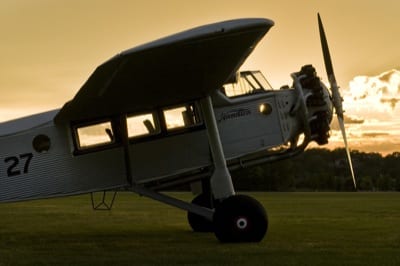 One of the rarest classic aircraft in the world, a fully-restored 1929 Hamilton Metalplane H-47 (serial No. 65), will be sold during the 39th Annual Barrett-Jackson Collector Car Auction in Scottsdale on Jan. 18-24, 2010. The historic Metalplane was No. 22 of only 29 built and is the only airworthy example of its type in existence.
One of the rarest classic aircraft in the world, a fully-restored 1929 Hamilton Metalplane H-47 (serial No. 65), will be sold during the 39th Annual Barrett-Jackson Collector Car Auction in Scottsdale on Jan. 18-24, 2010. The historic Metalplane was No. 22 of only 29 built and is the only airworthy example of its type in existence.
The Metalplane was originally sold in 1929 by the Hamilton Division of Boeing Aircraft to the Canadian Forestry Service. Following ownership by operators in Washington and Alaska, it was brought to St. Paul, Minn., in 1954 by Northwest Airlines pilot Harry McKee. There, Northwest Airlines’ “20 Year Club” began restoring the Metalplane, but stopped the job after only four months. The project was abandoned for several years until Jack Lysdale, an aviation expert at Fleming Field Airport in South St. Paul, purchased the aircraft and embarked on a full restoration of the rare Hamilton Metalplane in 1972.
During the restoration to original specifications, many parts had to be fabricated from scratch, including the seats, nose cowlings, firewall, fuel and oil tanks, controls and electrical systems. The Metalplane was reskinned with specially manufactured corrugated aluminum rolled from original dies by the Alcoa Company. The engine is a Pratt and Whitney Hornet R-1690 with 525 horsepower at 1900 rpm. The aircraft’s impeccable restoration, made possible by the talent and grit of Lysdale and his team, earned the Hamilton Metalplane the prestigious Grand Champion trophy at the Antique Airplane Association National Convention in 1975, as well as the Silver Age Champion award at Oshkosh in 1976.
“The rebirth of this Hamilton Metalplane is one of the most impressive restoration feats I’ve ever seen,” said Steve Davis, president of Barrett-Jackson. “From the rebuild of the Pratt and Whitney engine to the landing lights and handmade seats, Mr. Lysdale and his team spared no expense or attention to detail to return this aircraft to its original form.”
The Hamilton Metalplane will remain in St. Paul while it is being auctioned live in Scottsdale. A video highlighting its history and restoration will be shown to Barrett-Jackson attendees. Barrett-Jackson will host a preview of the Hamilton on Dec. 12-13 from 10 a.m.-3 p.m. at Fleming Field Airport. The preview will give potential buyers and aviation enthusiasts a chance to see the plane and ask questions before it is sold in January.
For more information: Barrett-Jackson.com or 480-421-6694.

This was one of the great “going-in-style” planes of the 1920s/early 1930s — and the perfect plane for countlesss headline-grabbing adventures and daring enterprises.
Hamilton Metalplane was one of a handful of “advanced” metal aircraft of the 1920s/early1930s — includng the similar Metal Aircraft Co. Flamingo (Columbus, OH), and the single-engine Stout airplanes that led to the Ford TriMotor. The Hamilton seems to have been the “Grumman Gulfstream” or “CRJ — Canadair Regional Jet” of its time — mixing a modest-but-useful passenger load with good performance (for the times), effeciency and range. A ruling by the government in the mid-1920s (1924, I think) — outlawing single-engine airliners — put a limit on this plane’s market potential (as with all single-engine airliners, including the heavy-hauling big Bellancas, the swift wooden Lockheed Vegas, the relatively compact Travel Airs and Cessnas, and such). More modern monocoque (hollow-shell) metal-liners came along soon, including the Boeing Monomail, Lockheed Orion, and Northrop Alpha/Beta, making the boxy metal craft obsolete. But these, too, succumbed to government requirements for multiple engines — each eclipsed quickly by multi-motored Boeing, Lockheed and other craft.
But the sturdy old slab-sided Hamiltons, Flamingos, and such (and their rag-winged & wooden-shelled brethren), remained prized as productive, efficent, sturdy, versatile utility aircraft, in remote places, long after they became “obsolete” — often outlasting the planes that had “replaced” them.
As a young boy (age 2 – 7) I grew up around the restoration of the Hamilton in Hangar #5 at the South St. Paul, MN airport. My father use to take me to the airport where he and others spent many years working with Jack Lysdale to complete the Hamilton. I remember one of the last things my father painted was the window frames and I helped remove the masking to reveal some great finishing touches to a great project and a great airplane. I have had the privilege to fly in this airplane and be a part of aviation history. As I recall it was a trip from South St. Paul to Owatonna. As an airplane of history it had basic instruments and the destination field was fogged in so we returned to South St. Paul.
I wanted to mention some of the names that I remember that were involved in recreating the master piece. Gary Mountain, Dick Willie, Art Krueger and many NWA mechanics including Bill Madden and Tiny Larson. A friend of my Grandparents did the wicker on the chairs. The first people to fly the Hamilton as I remember were Jack and along with him went Jim Schumacher.
I remember during my visits to the hanger where I did my share of sweeping and such, I would be able to play with a German shepherd named King and Jack’s cat named Hamilton.
Thanks for the memories you created with this project Jack, both personal and professional. May the final recipients of the Hamilton be able to share it with the public as you did flying it to the airshows.
John Mountain